
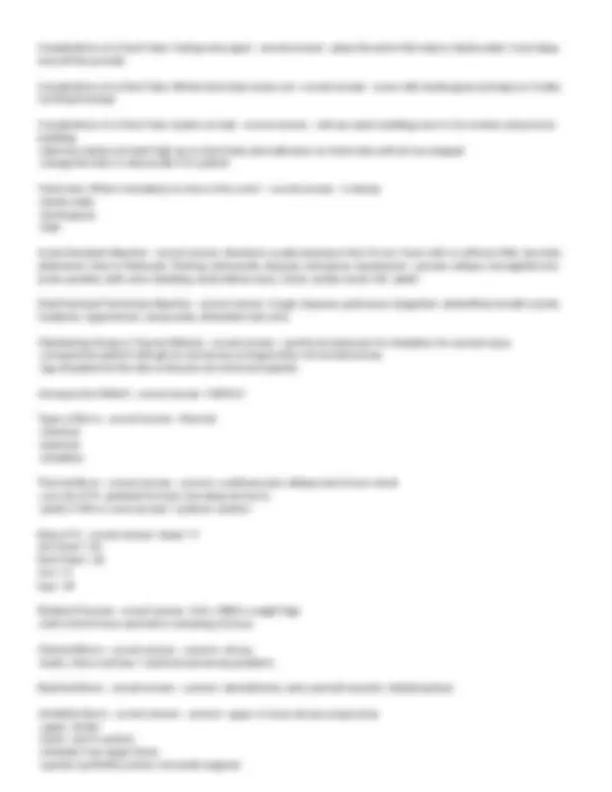
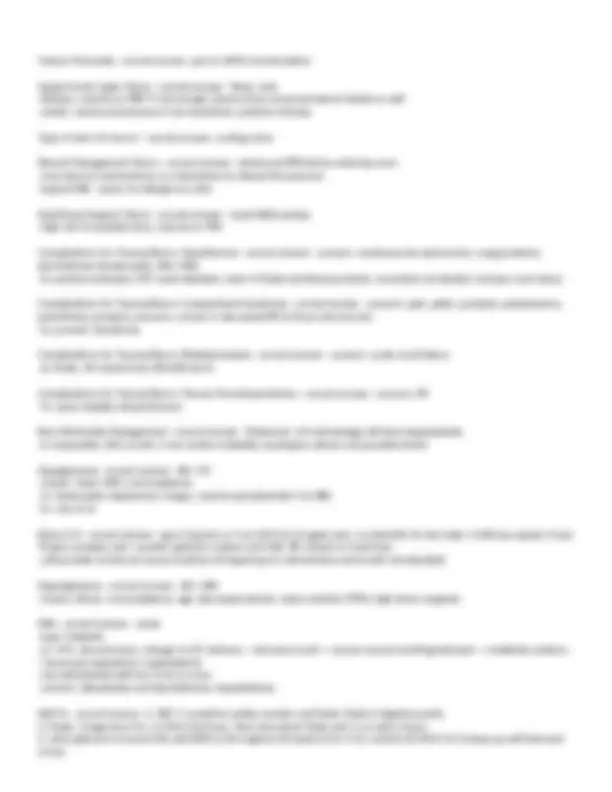
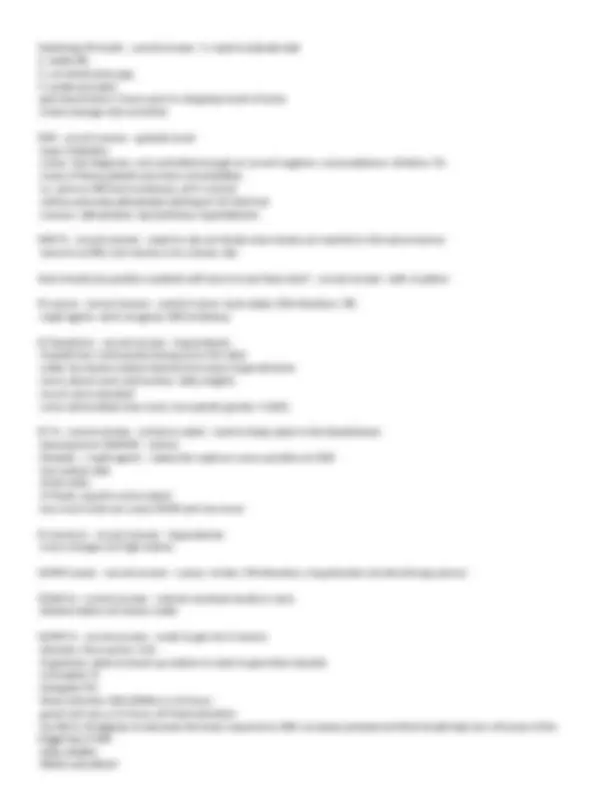
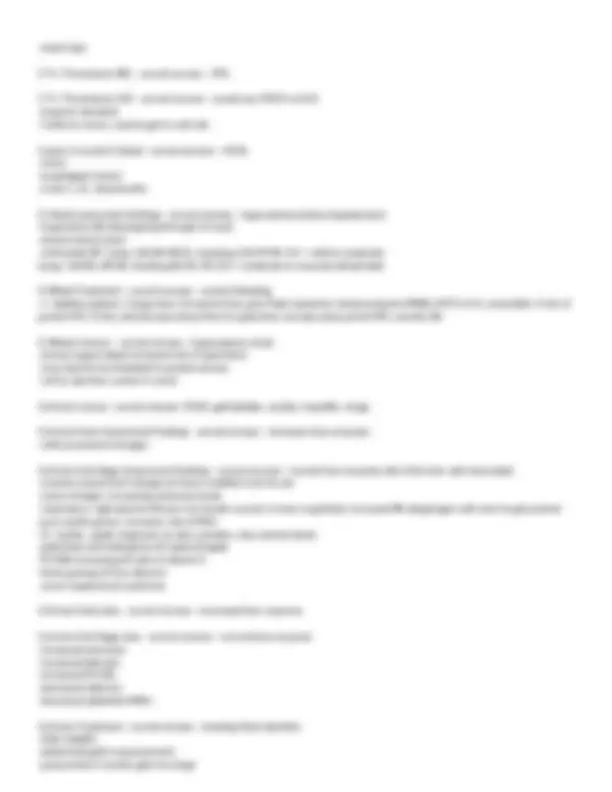
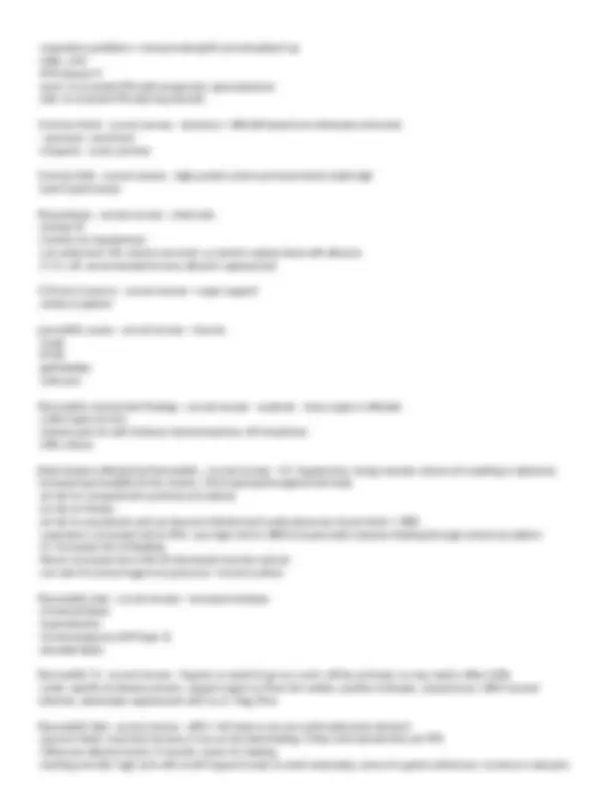



Study with the several resources on Docsity

Earn points by helping other students or get them with a premium plan


Prepare for your exams
Study with the several resources on Docsity

Earn points to download
Earn points by helping other students or get them with a premium plan
Community
Ask the community for help and clear up your study doubts
Discover the best universities in your country according to Docsity users
Free resources
Download our free guides on studying techniques, anxiety management strategies, and thesis advice from Docsity tutors
A detailed overview of various medical procedures and complications related to organ donation and chest tube management. It covers topics such as the correct steps for removing a chest tube, identifying and addressing complications like tubing coming apart or the entire chest tube coming out, mandatory equipment required for chest tube care, and the symptoms and management of acute hemolytic reactions and fluid overload transfusion reactions. The document also delves into the assessment, symptoms, and treatment of conditions like diabetes insipidus, siadh, gi bleeds, cirrhosis, and pancreatitis. With its comprehensive coverage of critical medical knowledge, this document could be a valuable resource for healthcare professionals, students, and anyone interested in understanding the complexities of organ donation and chest tube management.
Typology: Exams
1 / 10

This page cannot be seen from the preview
Don't miss anything!







Organ Donation Triggers - correct answer -1. talk about ventilator withdrawal/terminal wean
through the ribs -monitor for bleeding and pneumothorax -keep patient lying on right side for minimum of 2 hours Primary Survey - correct answer --done in 1-2 mins to set priority for patient -LOC: AVPU -A: Airway -> fire, chemical, C spine injury -B: Breathing -> contusion, fractured ribs, flail chest, neuro dysfunction to not able to move diaphragm deep enough, abdominal trauma affected diaphragm -C: Circulation -> control hemorrhage, 2 large bore IVs and administer fluids -D: dysfunction - neuro disabilities and cranial nerves -E: elements - is the patient safe, what is their exposure? -F: full set of VS/family - get quick info, allergies, what happened at scene, med hx -G: Get resuscitation adjuncts: FAST and EFAST FAST - correct answer -US to scan abdomen EFAST - correct answer -US scan to abdomen + lungs Secondary Survey - correct answer --patient needs to be stabilized first -HI: -H: full history -I: inspecting full head to toe and back of patient Halo Vest Care - correct answer -1. Inspect the pins on the halo traction ring. Report to HCP if pins are loose or signs of infection are present, including redness, tenderness, swelling, or drainage at insertion sites.
Carbon Monoxide - correct answer -put on 100% nonrebreather Support each organ: Burns - correct answer --Resp: vent -Kidneys: volume or CRRT if not enough volume since concerned about rhabdo as well -cardio: volume and pressors if we need them, positive inotrope Type of ulcer for burns? - correct answer -curlings ulcer Wound Management: Burns - correct answer --sterile and PPE before entering room -may need an escharotomy or a fasciotomy to release the pressure -topical ABX - assess for allergies to sulfa Nutritional Support: Burns - correct answer --need 5000 cal/day -high risk for paralytic ileus, may be on TPN Complications for Trauma/Burns: Hypothermia - correct answer --concern: cardiovascular dysfunction, coag problems, dysrhythmias (bradycardia, Afib, Vfib) -tx: positive inotropes, FFP, warm blankets, warm IV fluids and blood products, convection air blanket, increase room temp Complications for Trauma/Burns: Compartment Syndrome - correct answer --concern: pain, pallor, paralysis, pulselessness, paresthesia, paralysis, pressure, concern is decreased BF to tissue and necrosis -tx: prevent, fasciotomy Complications for Trauma/Burns: Rhabdomyolysis - correct answer --concern: acute renal failure -tx: fluids, UO needs to be 100-200 mL/hr Complications for Trauma/Burns: Venous Thromboembolism - correct answer --concern: PE -Tx: early mobility, blood thinners Burn Electrolyte Management - correct answer --Potassium: d/t cell damage will have hyperkalemia -tx: kayexalate, D50, insulin, if see cardiac instability would give calcium and possible bicarb Hypoglycemia - correct answer --BG < -causes: meds, NPO, noncompliance -sx: tachycardia, diaphoresis, hangry, may be asymptomatic if on BBs -tx: rule of 15 Rule of 15 - correct answer --give 15 grams or 4 oz (120 mL) of apple juice, re-check BG 15 mins later, if still low repeat, if over 70 give complex carb + protein (graham crackers and milk, PB, cheese or meal tray) -call provider to find out cause (could be d/t tapering of a steroid dose and insulin not adjusted) Hyperglycemia - correct answer --BG > -Causes: illness, noncompliance, age, decreased activity, meds nutrition (TPN), high stress surgeries DKA - correct answer --acute -type 1 diabetic -sx: 3 P's, blurred vision, change in LOC, ketones -> decrease in pH -> causes nausea/vomiting/abd pain -> metabolic acidosis -
kussmaul respirations, hyperkalemia -very dehydrated with loss of 6L or more -concern: dehydration and dysrhythmias, hyperkalemia DKA Tx - correct answer -1: ABC, C would be cardiac monitor and fluids, fluids is highest priority 2: Fluids: 2 large bore IVs, 1-2 NS in first hour, then slow down fluids and 1 L in next 2 hours 3: when glucose is around 250, add D5W to the regimen (K needs to be >3.3), need to 20-30 K+/hr to keep up with demand of loss
Switching off Insulin - correct answer -1. need to tolerate diet
Magnesium - correct answer - Vtach - correct answer -1. confirm if real, stable, unstable, or dead?
-chest tube 5 T's: Thrombosis (PE) - correct answer --TPA 5 T's: Thrombosis (MI) - correct answer --would see STEMI on ECG -troponin elevated -if able to revive, need to get to cath lab Causes of acute GI bleed - correct answer --AVMs -ulcers -esophageal varices -crohn's, UC, diverticulitis GI bleed assessment findings - correct answer --hypovolemia (tachy/hypotension) -hyperactive BS (blood going through GI tract) -emesis/stool (color) -orthostatic BP :Lying: 120/80 HR 82, standing 118/78 HR 115 = mild to moderate Lying: 120/80, HR 80, standing 80/50, HR 125 = moderate to severely dehydrated GI Bleed Treatment - correct answer --control bleeding -1. stabilize patient, 2 large bore IVs/central line, give fluids (isotonic), blood products (PRBCs/FFP 3-4/1), octreotide: if risk of portal HTN, IV/SQ, will decrease blood flow to splanchnic and decrease portal HTN, monitor BG GI Bleed Concern - correct answer --hypovolemic shock -airway (upper bleed increased risk of aspiration) -may need to be intubated to protect airway -roll to side then suction if vomit Cirrhosis Causes - correct answer -ETOH, gall bladder, cardiac, hepatitis, drugs Cirrhosis Early Assessment Findings - correct answer --increases liver enzymes -mild assessment changes Cirrhosis End Stage Assessment Findings - correct answer --normal liver enzymes (all of the liver cells have died) -massive assessment changes d/t livers inability to do its job -neuro changes: increasing ammonia levels -respiratory: right pleural effusion (no breath sounds in lower lung field), increased RR (diaphragm with start to get pushed up as ascites grows, increases risk of PNA) -GI: ascites, spider angiomas on abd, jaundice, clay colored stools -petechiae and leukopenia d/t splenomegaly -PT/INR increasing d/t lack of vitamin K -third spacing d/t low albumin -renal: hepatorenal syndrome Cirrhosis Early Labs - correct answer --increased liver enzymes Cirrhosis End Stage Labs - correct answer --normal liver enzymes -increased ammonia -increased bilirubin -increased PT/INR -decreased albumin -decreased platelets/WBCs Cirrhosis Treatment - correct answer --tracking fluid retention -daily weights -abdominal girth measurements -paracentesis if ascites gets too large
and increase in labs Pancreatitis Concerns - correct answer --organ support -calcium level -tx like they have shock